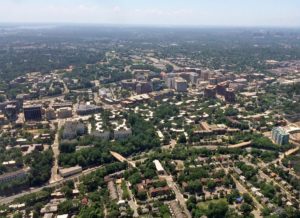 Where should new schools, parks and fire stations be built in Arlington? Which existing county facilities should stay the same and which might be due for a renovation or change in use?
Where should new schools, parks and fire stations be built in Arlington? Which existing county facilities should stay the same and which might be due for a renovation or change in use?
Those are the questions being tackled by Arlington’s Community Facilities Study Committee, and today residents will get to get a glimpse of the committee’s work up close at an open house in Courthouse.
The drop-in open house is being held from noon to 3 p.m. and from 4-9 p.m. at the county government headquarters building (2100 Clarendon Blvd). Attendees will be able to talk to members of the study’s committee and ask about the study’s process and findings.
The Community Facilities Study is an analysis of Arlington that looks at the population and current needs of residents to project Arlington’s facilities needs in the near and long-term future. The study will predict what the demographics of the county will be and how this will that affect what new public buildings will be needed. The study began in January 2015 and is slated to end November 2015.
This information will be shared with the County Board and the school board so that elected officials can decide if more public buildings, such as schools, fire stations and recreational centers, are needed.
“Arlington is changing in pretty significant ways,” said Ginger Brown, the vice chair of the Community Facilities Study committee. While Arlington’s population has continued to grow, the amount of available land continues to shrink. The lack of land is the county’s biggest problem.
The problem can be seen as a good problem to have, said John Milliken, chair of the committee. It is a more “upbeat” challenge when people are coming to Arlington, he said.
Arlington has a great location, great school system and a good transit system, which make Arlington an attractive place for people and companies, Milliken said.
“These fundamentals will always be at the center of Arlington’s strengths,” he said.
While Arlington has a well-regarded school system, the schools are becoming increasingly overpopulated due to one of the fastest growing populations: school-age children. Arlington Public Schools has been building new schools and additions, but has so far not caught up with the rising population, leading to the use of more relocatable classrooms.
The committee will not ultimately decide on new schools or where they would be, Milliken said, that responsibility is with the school board. Even if the school board does decide to build a new school, the process can take over a year if there are no problems, Milliken noted.
The other two quickly growing populations are residents 85+ years of age and millennials, each with their own challenges.
The 85+ age group presents what Milliken called a “happy but new challenge.” While some older residents will want to stay in their homes, others will want to downsize or move to senior living communities. It is also a question of what social support and recreational activities they will need, he said.
The 23-person committee does not know what these services will be yet.
Millennials have been the dominant population in Arlington in 2010, according to the committee’s website, but if they will become stay and become permanent residents is still a question.
“We would love them to stay in Arlington,” Milliken said.
The committee is attempting to project if the millennial population will be able to afford housing in Arlington in the near future, when they might start looking to raise a family and move out of apartments and into a single-family home. Millennials who decide to settle down in Arlington and start families will help keep the school populations and tax base healthy in the future.
The committee also to work on communicating with millennials, Brown said. The committee looks at how to make Arlington attractive for the group and one way is the good school system, she said. Young families want to put roots down in places that will give their children a good education.
For the younger end of the demographic, the committee is looking at different housing options that might be more affordable for single millennials.
“We are going to need a variety of housing options,” Brown said.
With the changing population comes a shift in Arlington’s economic landscape. The federal government and the military have been moving offices away from Arlington, leaving the county with empty office space. Arlington now needs to find private businesses to take over this space.
“We can no longer be government dependent,” Milliken said.
Milliken said technology companies could the next big office tenant for the area. Bringing them to Arlington will require a continued conscious effort to make the area attractive to such companies.
Attracting new companies means making sure there is a good school system, a good workforce and easy access to transit, Milliken said, as CEOs of companies will ask about these before choosing to move or start a company in a given area.
The empty office space also comes from a change in overall office trends. Increasingly, companies need less space for their employees and are using more collaborative spaces for their companies, Milliken said.
Another promising development is the hybrid living and work space, from the coworking office company WeWork, that’s coming to Crystal City. “WeLive” will s have housing, with rooms about the size of dormitory rooms, and then collaborative spaces for young entrepreneurs to brainstorm new businesses, Milliken said. Encouraging such innovative projects may be one way Arlington chooses to bring more businesses to the area.
“There may be a lot of challenges, but there are a lot of opportunities in front of us,” Brown said.

